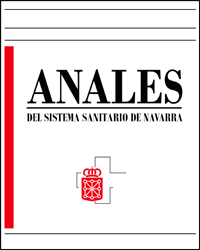Hypobaric spinal anesthesia in a large ventral hernia
DOI:
https://doi.org/10.23938/ASSN.0585Keywords:
Spinal anesthesia. Bupivacaine. Umbilical hernia. Ventral hernia. Airway management.Abstract
High abdominal wall surgery may require general anesthesia but, in patients with high risk of difficult airway and respiratory complications, local or regional anesthesia is the choice whenever possible. Spinal anesthesia usually used (both isobaric and hyperbaric) could compromise the respiratory function due to blockade of the T6 metamere or higher. Hypobaric spinal anesthesia (HSA) at low doses (3.6 cc of 0.1% hypobaric bupivacaine plus 0.2 cc of 0.005% fentanyl) achieves sufficient analgesia with minimal motor blockade.
We present the case of a patient with a large supraumbilical hernia with high risk of difficult airway and respiratory complications, who went through HSA. The patient did not report pain or dyspnea during the surgical procedure thus, HSA at low doses is an option to be taken into account in high abdominal wall surgery despite not having been described for this use.
Downloads
References
KROBOT R, PREMUŽIĆ J. Comparison of general and spinal anaesthesia in patients undergoing open ventral hernia repair. Period Biol 2013; 115: 225-229.
TZOVARAS G, ZACHAROULIS D, GEORGOPOULOU S, PRATSAS K, STAMATIOU G, HATZITHEOFILOU C. Laparoscopic ventral hernia repair under spinal anesthesia: a feasibility study. Am J Surg 2008; 196: 191-194. https://doi.org/10.1016/j.amjsurg.2007.07.028
VIJAY SARASWAT. Effects of anaesthesia techniques and drugs on pulmonary function. Indian J Anaesth 2015; 59: 557-564. https://doi.org/10.4103/0019-5049.165850
MEURET P, BOUVET L, VILLET B, HAFEZ M, ALLAOUCHICHE B, BOSELLI E. Hypobaric unilateral spinal anaesthesia versus general anaesthesia in elderly patients undergoing hip fracture surgical repair: a prospective randomised open trial. Turk J Anaesthesiol Reanim 2018; 46: 121-130. https://doi.org/10.5152/TJAR.2018.90699
MAROOF M, KHAN RM, SIDDIQUE M, TARIQ M. Hypobaric spinal anaesthesia with bupivacaine (0.1%) gives selective sensory block for ano-rectal surgery. Can J Anaesth 1995; 42: 691-694. https://doi.org/10.1007/BF03012666
VERGARI A, FRASSANITO L, NESTORINI R, CAPUTO CT, CHIERICHINI A, DI STASIO E et al. Hypobaric versus isobaric spinal levobupivacaine for total hip arthroplasty. Minerva Anestesiol 2017; 83: 361-368. https://doi.org/10.23736/S0375-9393.16
TASPINAR V, SAHIN A, DONMEZ NF, PALA Y, SELCUK A, OZCAN M et al. Low-dose ropivacaine or levobupivacaine walking spinal anesthesia in ambulatory inguinal herniorrhaphy. J Anesth 2011; 25: 219-224; https://doi.org/10.1007/s00540-010-1089-9
DONATI M, BRANCATO G, DONATI A. Open incisional hernia repair under local anaesthesia. Acta Chir Belg 2010; 110: 45-50. https://doi.org/10.1080/00015458.2010.11680564
STIERER TL. Obstructive sleep apnea, sleep disorders and perioperative considerations. Review article. Anesthesiol Clin 2015; 33: 305-314. https://doi.org/10.1016/j.anclin.2015.02.003
SMETANA GW, LAWRENCE VA, CORNELL JE, American College of Physicians. Preoperative pulmonary risk stratification for noncardiothoracic surgery: systematic review for the American College of Physicians. Ann Intern Med 2006; 144: 581-595. https://doi.org/10.7326/0003-4819-144-8-200604180-00009
DHUMANE PG, MUTJABA TISN. Efficacy of spinal anaesthesia for laparoscopic ventral hernia repair. Int J Biomed Res 2016; 7: 201-206.
CANET J, GALLART L, GOMAR C, PALUZIE G, VALLÈS J, CASTILLO J et al. Prediction of postoperative pulmonary complications in a population-based surgical cohort. Anesthesiology 2010; 113: 1338-1350. https://doi.org/10.1097/ALN.0b013e3181fc6e0a
Downloads
Published
How to Cite
Issue
Section
License
Copyright (c) 2019 Anales del Sistema Sanitario de Navarra

This work is licensed under a Creative Commons Attribution-ShareAlike 4.0 International License.
La revista Anales del Sistema Sanitario de Navarra es publicada por el Departamento de Salud del Gobierno de Navarra (España), quien conserva los derechos patrimoniales (copyright ) sobre el artículo publicado y favorece y permite la difusión del mismo bajo licencia Creative Commons Reconocimiento-CompartirIgual 4.0 Internacional (CC BY-SA 4.0). Esta licencia permite copiar, usar, difundir, transmitir y exponer públicamente el artículo, siempre que siempre que se cite la autoría y la publicación inicial en Anales del Sistema Sanitario de Navarra, y se distinga la existencia de esta licencia de uso.








